
Star Wars: X-Wing vs. TIE Fighter is a 1997 space combat game developed by Totally Games for LucasArts. It is the third installment of the X-Wing series.

Donkey Kong 3 is a shooter video game developed and published by Nintendo. It is the third installment in the Donkey Kong series and was released for arcades worldwide in 1983, the Family Computer in 1984, then in North America for the Nintendo Entertainment System in 1986. The gameplay departs from previous Donkey Kong games, and it stars an exterminator named Stanley instead of Mario.

Sid Meier's Civilization II is a turn-based strategy video game in the Civilization series, developed and published by MicroProse. It was released in 1996 for PCs, and later ported to the PlayStation by Activision.

Oddworld: Abe's Oddysee is a platform video game developed by Oddworld Inhabitants and published by GT Interactive. It was released in 1997 for the PlayStation game console, and computers running MS-DOS and Windows. A Game Boy version was released as Oddworld Adventures in 1998.

Streets of SimCity is a racing and vehicular combat 3D computer game published by Maxis and Electronic Arts in November 1997. The game features the ability to visit any city created in SimCity 2000, as well as a network mode, allowing for players to play deathmatches with up to seven other players. It is the last Maxis game to be developed and released without supervision by Electronic Arts, which acquired Maxis in the two months leading up to release.

Krome Studios Melbourne, originally Beam Software, was an Australian video game development studio founded in 1980 by Alfred Milgrom and Naomi Besen and based in Melbourne, Australia. Initially formed to produce books and software to be published by Melbourne House, a company they had established in London in 1977, the studio operated independently from 1987 until 1999, when it was acquired by Infogrames, who changed the name to Infogrames Melbourne House Pty Ltd.. In 2006 the studio was sold to Krome Studios.

Star Wars: Force Commander is a real-time strategy video game released for the Microsoft Windows platform in 2000. It was co-developed by Ronin Entertainment and LucasArts, and published by LucasArts. Its plot interweaves between Star Wars: A New Hope and Return of the Jedi, taking place in key battles. Peter McConnell created remixed tracks of John Williams's original score with influences from hard rock and techno music.
Ultimate Soccer Manager (USM) is an association football management video game series for DOS, Commodore Amiga and Windows 95, produced by Impressions and distributed by Sierra from 1995 to 1999. The game was a massive hit in Europe, although it gained little support in Japan.

Bug! is a platform game developed by Realtime Associates and published by Sega for the Sega Saturn. It was first released in North America, in 1995, weeks after the Saturn's launch there; in Europe on September 15, 1995; and, in Japan, on December 8 the same year. It was also ported to Windows 3.1x and Windows 95 in 1996 by Beam Software. The game is one of the earliest examples of 3D platforming, as well as one of the first platform games released on the Saturn. Character movement is restricted to a track, unlike many in the genre that allow for unrestricted movement in all directions.
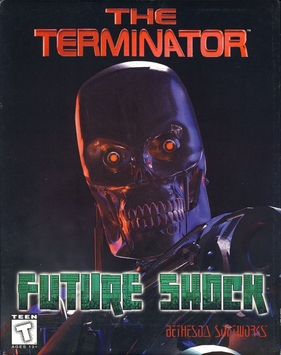
The Terminator: Future Shock is a first-person shooter video game based on The Terminator fictional universes developed and published by Bethesda Softworks in 1995. A sequel, Skynet, was released in 1996.
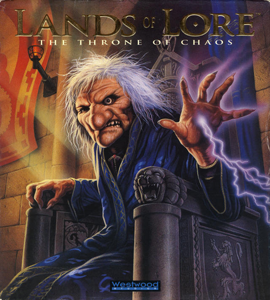
Lands of Lore: The Throne of Chaos is a 1993 role-playing video game developed by Westwood Studios and published by Virgin Games for MS-DOS, the NEC PC-9801, and FM Towns. It was the first installment of the Lands of Lore series. The player travels around various environments, collecting items and battling monsters in an attempt to save the kingdom from a witch named Scotia, who has acquired shape-shifting abilities.

Baldies is a 1995 real-time strategy video game developed by Creative Edge Software and originally published by Atari Corporation for the Atari Jaguar CD. It was later ported to the PC, PlayStation, Sega Saturn, and Macintosh. In the game, the player manages a community of Baldies in order to build structures, increase their population, and create weapons to fight against enemies known as Hairies. There are four classes of Baldies and each structure has specific properties to assist the player. Its gameplay combines strategy with simulation and god game elements. Up to four players can participate in a multiplayer mode via local area network (LAN) on PC.
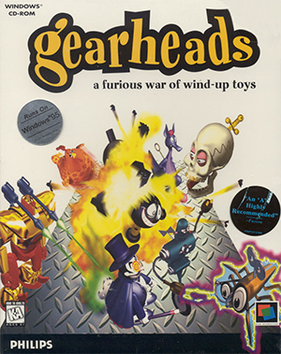
Gearheads is a strategy video game developed by R/GA Interactive and Philips Media, and published by Philips Media for Microsoft Windows and Mac OS in June 1996. The player deploys wind-up toys to get them across an arena while attempting to prevent toys from crossing from the other side. Players can play against the computer or another player. Single, customisable games can be played, or the player can play a series of games with set rules and a limited number of lives in a tournament.
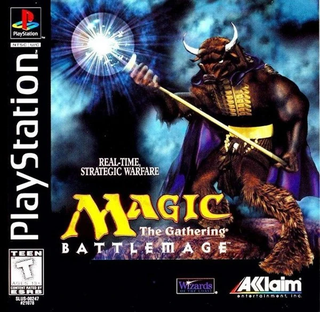
Magic: The Gathering: BattleMage is a real time strategy game published in January 1997 by Acclaim for both PCs and PlayStation. It was also in development for the Sega Saturn, but this version was cancelled in mid-1997.

Dark Souls II is a 2014 action role-playing game developed by FromSoftware. The second installment of the Dark Souls series, it was released for Windows, PlayStation 3 and Xbox 360 by FromSoftware in Japan and Bandai Namco Games internationally. Taking place in the kingdom of Drangleic, the game follows a cursed undead character searching for a cure to their affliction. Dark Souls II was released in March 2014 after some initial delays, with the Windows version being released the following month.

F1 Manager is a sports video game developed by Intelligent Games and published by EA Sports exclusively for Microsoft Windows. It was the last officially licensed F1 Management game until F1 Manager 2022 by Frontier Developments.

D.A. Pursuit of Justice is a three-part video game series based around a criminal lawyer who is trying to convict guilty people. The three individual cases were sold separately or also as a three-case 8-CD bundle published by Alpha Software, shipped on September 15, 1997. The game is part of Legacy Software's RealPlay Series.

Fire Fight is an isometric shoot 'em up video game developed by Polish studio Chaos Works, produced by Epic MegaGames and published by Electronic Arts for Windows.

Starfield is a 2023 action role-playing game developed by Bethesda Game Studios and published by Bethesda Softworks. In the game, the player character joins a group of space explorers who must venture to various corners of the galaxy to acquire mysterious artifacts. The game features an open world in the form of an area within the Milky Way galaxy, containing both fictional and non-fictional planetary systems.
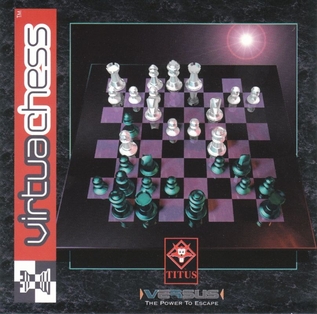
Virtua Chess is a 1995 chess video game developed and published by Titus France SA for the MS-DOS. It was later ported to Windows. Two sequels were released: Virtual Chess 2 for the Windows in 1997 and Virtual Chess 64 for the Nintendo 64 in 1998.


















